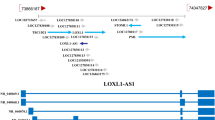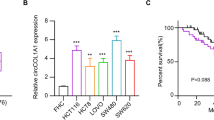Abstract
Urothelial carcinoma associated 1 (UCA1) has been identified as an oncogenic long noncoding RNA (lncRNA) that is involved in bladder cancer progression and acts as a diagnostic biomarker for bladder carcinoma. Here, we studied the expression and function of lncRNA-UCA1 in the hypoxic microenvironment of bladder cancer. The expression and transcriptional activity of lncRNA-UCA1 were measured by quantitative real-time polymerase chain reaction and luciferase assays. Cell proliferation and apoptosis were evaluated by MTT assays and flow cytometry. Cell migration and invasion were detected by wound healing, migration, and invasion assays. The binding of hypoxia-inducible factor-1α (HIF-1α) to hypoxia response elements (HREs) in the lncRNA-UCA1 promoter was confirmed by electrophoretic mobility shift assay and chromatin immunoprecipitation. HRE mutations were generated by using a site-directed mutagenesis kit, and HIF-1α knockdown was mediated by small interfering RNA. The effect of HIF-1α inhibition by YC-1 on lncRNA-UCA1 expression was also examined. LncRNA-UCA1 was upregulated by hypoxia in bladder cancer cells. Under hypoxic conditions, lncRNA-UCA1 upregulation increased cell proliferation, migration, and invasion and inhibited apoptosis. The underlying mechanism of hypoxia-upregulated lncRNA-UCA1 expression was that HIF-1α specifically bound to HREs in the lncRNA-UCA1 promoter. Furthermore, HIF-1α knockdown or inhibition could prevent lncRNA-UCA1 upregulation under hypoxia. These findings revealed the mechanism of lncRNA-UCA1 upregulation in hypoxic bladder cancer cells and suggested that effective blocking of lncRNA-UCA1 expression in the hypoxic microenvironment of bladder cancer could be a novel therapeutic strategy.






Similar content being viewed by others
References
Ruan K, Song G, Ouyang G. Role of hypoxia in the hallmarks of human cancer. J Cell Biochem. 2009;107(6):1053–62. doi:10.1002/jcb.22214.
Wang GL, Jiang BH, Rue EA, Semenza GL. Hypoxia-inducible factor 1 is a basic-helix-loop-helix-PAS heterodimer regulated by cellular O2 tension. Proc Natl Acad Sci U S A. 1995;92(12):5510–4.
Jaakkola P, Mole DR, Tian YM, Wilson MI, Gielbert J, Gaskell SJ, et al. Targeting of HIF-alpha to the von Hippel-Lindau ubiquitylation complex by O2-regulated prolyl hydroxylation. Science. 2001;292(5516):468–72. doi:10.1126/science.1059796.
Semenza GL. HIF-1, O2, and the 3 PHDs: how animal cells signal hypoxia to the nucleus. Cell. 2001;107(1):1–3.
Majmundar AJ, Wong WJ, Simon MC. Hypoxia-inducible factors and the response to hypoxic stress. Mol Cell. 2010;40(2):294–309. doi:10.1016/j.molcel.2010.09.022.
Keith B, Simon MC. Hypoxia-inducible factors, stem cells, and cancer. Cell. 2007;129(3):465–72. doi:10.1016/j.cell.2007.04.019.
Jacobs BL, Lee CT, Montie JE. Bladder cancer in 2010: how far have we come? CA Cancer J Clin. 2010;60(4):244–72. doi:10.3322/caac.20077.
Gospodarowicz M. Combination therapy: hypoxia modification with radiotherapy for bladder cancer. Nat Rev Clin Oncol. 2011;8(3):129–30. doi:10.1038/nrclinonc.2011.5.
Theodoropoulos VE, Lazaris A, Sofras F, Gerzelis I, Tsoukala V, Ghikonti I, et al. Hypoxia-inducible factor 1 alpha expression correlates with angiogenesis and unfavorable prognosis in bladder cancer. Eur Urol. 2004;46(2):200–8. doi:10.1016/j.eururo.2004.04.008.
Chen MC, Lee CF, Huang WH, Chou TC. Magnolol suppresses hypoxia-induced angiogenesis via inhibition of HIF-1alpha/VEGF signaling pathway in human bladder cancer cells. Biochem Pharmacol. 2013;85(9):1278–87. doi:10.1016/j.bcp.2013.02.009.
Orom UA, Derrien T, Beringer M, Gumireddy K, Gardini A, Bussotti G, et al. Long noncoding RNAs with enhancer-like function in human cells. Cell. 2010;143(1):46–58.
Lee JT. Epigenetic regulation by long noncoding RNAs. Science. 2012;338(6113):1435–9.
Gutschner T, Diederichs S. The hallmarks of cancer: a long non-coding RNA point of view. RNA Biol. 2012;9(6):703–19. doi:10.4161/rna.20481.
Panzitt K, Tschernatsch MM, Guelly C, Moustafa T, Stradner M, Strohmaier HM, et al. Characterization of HULC, a novel gene with striking up-regulation in hepatocellular carcinoma, as noncoding RNA. Gastroenterology. 2007;132(1):330–42. doi:10.1053/j.gastro.2006.08.026.
Wang F, Li X, Xie X, Zhao L, Chen W. UCA1, a non-protein-coding RNA up-regulated in bladder carcinoma and embryo, influencing cell growth and promoting invasion. FEBS Lett. 2008;582(13):1919–27. doi:10.1016/j.febslet.2008.05.012.
Chen G, Wang Z, Wang D, Qiu C, Liu M, Chen X, et al. LncRNADisease: a database for long-non-coding RNA-associated diseases. Nucleic Acids Res. 2013;41(Database issue):D983–6. doi:10.1093/nar/gks1099.
Zhang Q, Su M, Lu G, Wang J. The complexity of bladder cancer: long noncoding RNAs are on the stage. Mol Cancer. 2013;12(1):101. doi:10.1186/1476-4598-12-101.
Loscalzo J. The cellular response to hypoxia: tuning the system with microRNAs. J Clin Invest. 2010;120(11):3815–7. doi:10.1172/JCI45105.
Yang C, Li X, Wang Y, Zhao L, Chen W. Long non-coding RNA UCA1 regulated cell cycle distribution via CREB through PI3-K dependent pathway in bladder carcinoma cells. Gene. 2012;496(1):8–16. doi:10.1016/j.gene.2012.01.012.
Wu W, Zhang S, Li X, Xue M, Cao S, Chen W. Ets-2 regulates cell apoptosis via the Akt pathway, through the regulation of urothelial cancer associated 1, a long non-coding RNA, in bladder cancer cells. PLoS ONE. 2013;8(9):e73920. doi:10.1371/journal.pone.0073920.
Cartharius K, Frech K, Grote K, Klocke B, Haltmeier M, Klingenhoff A, et al. MatInspector and beyond: promoter analysis based on transcription factor binding sites. Bioinformatics. 2005;21(13):2933–42. doi:10.1093/bioinformatics/bti473.
Portales-Casamar E, Thongjuea S, Kwon AT, Arenillas D, Zhao X, Valen E, et al. JASPAR 2010: the greatly expanded open-access database of transcription factor binding profiles. Nucleic Acids Res. 2010;38(Database issue):D105–10. doi:10.1093/nar/gkp950.
Ching CB, Hansel DE. Expanding therapeutic targets in bladder cancer: the PI3K/Akt/mTOR pathway. Lab Invest. 2010;90(10):1406–14. doi:10.1038/labinvest.2010.133.
Calderaro J, Rebouissou S, de Koning L, Masmoudi A, Herault A, Dubois T, et al. PI3K/AKT pathway activation in bladder carcinogenesis. Int J Cancer. 2014;134(8):1776–84. doi:10.1002/ijc.28518.
Maddika S, Ande SR, Panigrahi S, Paranjothy T, Weglarczyk K, Zuse A, et al. Cell survival, cell death and cell cycle pathways are interconnected: implications for cancer therapy. Drug Resist Updat. 2007;10(1–2):13–29. doi:10.1016/j.drup.2007.01.003.
Matouk IJ, DeGroot N, Mezan S, Ayesh S, Abu-lail R, Hochberg A, et al. The H19 non-coding RNA is essential for human tumor growth. PLoS ONE. 2007;2(9):e845. doi:10.1371/journal.pone.0000845.
Matouk IJ, Mezan S, Mizrahi A, Ohana P, Abu-Lail R, Fellig Y, et al. The oncofetal H19 RNA connection: hypoxia, p53 and cancer. Biochim Biophys Acta. 2010;1803(4):443–51. doi:10.1016/j.bbamcr.2010.01.010.
Yang F, Huo XS, Yuan SX, Zhang L, Zhou WP, Wang F, et al. Repression of the long noncoding RNA-LET by histone deacetylase 3 contributes to hypoxia-mediated metastasis. Mol Cell. 2013;49(6):1083–96. doi:10.1016/j.molcel.2013.01.010.
Yang F, Zhang H, Mei Y, Wu M. Reciprocal regulation of HIF-1alpha and lincRNA-p21 modulates the Warburg effect. Mol Cell. 2014;53(1):88–100. doi:10.1016/j.molcel.2013.11.004.
Rankin EB, Giaccia AJ. The role of hypoxia-inducible factors in tumorigenesis. Cell Death Differ. 2008;15(4):678–85. doi:10.1038/cdd.2008.21.
Fazilaty H, Gardaneh M, Bahrami T, Salmaninejad A, Behnam B. Crosstalk between breast cancer stem cells and metastatic niche: emerging molecular metastasis pathway? Tumour Biol. 2013;34(4):2019–30. doi:10.1007/s13277-013-0831-y.
Semenza GL. Cancer-stromal cell interactions mediated by hypoxia-inducible factors promote angiogenesis, lymphangiogenesis, and metastasis. Oncogene. 2013;32(35):4057–63. doi:10.1038/onc.2012.578.
Semenza GL. Targeting HIF-1 for cancer therapy. Nat Rev Cancer. 2003;3(10):721–32. doi:10.1038/nrc1187.
Zhang T, Fan J, Wu K, Zeng J, Sun K, Guan Z, et al. Roles of HIF-1alpha in a novel optical orthotopic spontaneous metastatic bladder cancer animal model. Urol Oncol. 2012;30(6):928–35. doi:10.1016/j.urolonc.2012.01.003.
Li Y, Zhao X, Tang H, Zhong Z, Zhang L, Xu R, et al. Effects of YC-1 on hypoxia-inducible factor 1 alpha in hypoxic human bladder transitional carcinoma cell line T24 cells. Urol Int. 2012;88(1):95–101. doi:10.1159/000331881.
Acknowledgments
This work was supported by the grants (No. 81072104) from the National Natural Science Foundation of China.
Conflicts of interest
None.
Author information
Authors and Affiliations
Corresponding author
Electronic supplementary material
Below is the link to the electronic supplementary material.
Supplementary Figure 1
a lncRNA-UCA1 expression levels were analyzed by PCR in SKOV3 cells under both normoxia and hypoxia. 18S rRNA was used as the internal control (*P < 0.05, n = 3). Line 1-2 indicated normoxic SKOV3 cells; line 3-4 indicated hypoxic SKOV3 cells. b ChIP showed the interaction of HIF-1α with the lncRNA-UCA1 promoter in hypoxic SKOV3 cells (*P < 0.05, n = 3) (GIF 37 kb)
Rights and permissions
About this article
Cite this article
Xue, M., Li, X., Li, Z. et al. Urothelial carcinoma associated 1 is a hypoxia-inducible factor-1α-targeted long noncoding RNA that enhances hypoxic bladder cancer cell proliferation, migration, and invasion. Tumor Biol. 35, 6901–6912 (2014). https://doi.org/10.1007/s13277-014-1925-x
Received:
Accepted:
Published:
Issue Date:
DOI: https://doi.org/10.1007/s13277-014-1925-x




